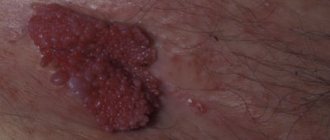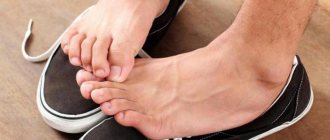Eczema in the groin is a disease that is not as often diagnosed by specialists as dermatoses in any other parts of the body, but due to its specific location, in most cases the rashes characteristic of it are fraught with many complications. It is impossible to say exactly the reasons why the pathology occurs, but it is known that without deviations in the functioning of the endocrine system and a weakened immune system, the chances of its development are negligible.
In official medicine, eczema in the groin is most often found under a different name - athlete's foot, eczema of the Coat of Arms or eczema bordered. The symptoms of the disease practically do not differ from the main signs of dermatosis, so recognizing the disease does not cause difficulties even among patients. The disease is diagnosed in both sexes, but most often the pathology occurs in men. Manifestations of the pathology are localized in the inguinal folds, which causes discomfort and pain to the patient. Often the trigger for the disease is triggered after excessive sweating or excessive physical exertion. Eczema in the groin area is quite common: according to statistics, 2 out of 10 men are familiar with athlete's foot today.
Eczema in the groin in most cases is fraught with many complications
The disease does not pose a danger to the patient’s life, but it is quite difficult to get rid of it. Sometimes long-term qualified treatment does not bring the expected results. Eczema in the groin rapidly progresses and becomes chronic. Therefore, at the first symptoms, you should pay attention to your health and urgently seek help from specialists. Self-medication in this case is ineffective; moreover, taking medications without a doctor’s prescription can aggravate an already difficult situation.
Stages of the disease and main types of dermatosis in the groin area
Eczema in the groin can be of several types; the most often diagnosed is the idiopathic form of dermatosis. However, microbial, seborrheic and mycotic varieties also occur in both men and women. As already mentioned, any type of disease is characterized by an undulating course, in which relapses are replaced by short remissions.
It is worth noting that eczematous lesions are almost never isolated. As a rule, the first symptoms of eczema in the groin appear immediately in symmetrical areas.
Painful rashes that go through several stages of development can be characterized as follows:
- First, spots of a pale pink hue appear, they have clear boundaries marked by a brighter roller, they become as if bordered (hence the disease received the name of the same name). It is at this stage of eczema in the groin that treatment must begin.
- Foci of dermatosis spread throughout the groin area within a few days; the epidermis in the inflamed areas begins to dry and peel.
- The rash spots join together to form large, painful lesions.
- The entire wound surface is covered with small papules, which will soon turn into vesicles.
- After a couple of days, vesicular formations filled with clear serous fluid become like huge blisters.
- The vesicles burst, and the exudate comes out, covering almost the entire wound surface. Weeping is difficult to treat.
- As soon as the exudate begins to dry out and form crustose crusts, the pathological process comes to an end, and the affected areas begin to heal.
What are the symptoms of eczema in intimate places?
Eczema in the groin in women and men usually occurs polymorphically, i.e. At the same time, the patient can notice papules, weeping areas, peeling, and serous cortical surfaces. The aesthetic defect of the disease is not the only problem that the disease causes the patient.
Foci of eczema in the groin at any stage are accompanied by the following sensations:
- severe constant itching;
- swelling;
- pain when touching, walking and physical activity;
- burning sensation and swelling;
- thickening and pigmentation of the skin during healing.
Eczema in the groin (especially common in men) causes a decrease in performance, prevents proper rest, which entails neurotic disorders. The patient suffers from insomnia, becomes irritable and weakened. Constant scratching often leads to bacterial or fungal infections.
Causes
Before talking about the reasons for the formation of the disease, it should be noted that genital eczema is not a threat to other people; the infection will not spread from infected skin to healthy skin. The non-contagious nature of the disease has nothing to do with the patient’s sexual partners.
The reason often lies in contraception: personal intolerance to latex products, allergies to fragrances and lubricants are popular triggers of the disease. The reasons that lead to the formation of genital eczema are external and internal.
External ones are:
- the use of personal hygiene that irritate the skin of the genitals;
- wearing synthetic and too tight clothing;
- allergies to specific substances;
- prolonged use of antibiotics;
- prolonged depression, constant stressful situations.
Internal factors are:
- diseases of the gastrointestinal tract;
- functional disorders of the endocrine and nervous system;
- deterioration of the immune system;
- genetic predisposition.
Genital eczema is often the result of various disorders within the human body or the unfavorable influence of hygiene items and clothing. In view of this, it would be optimal to first identify the source of the disease and focus on its elimination.
What causes skin pathology in the groin?
Considering the causes of eczema in the groin, it is worth noting that the disease occurs against the backdrop of a weakening of the body’s defenses. As a rule, it is the mycotic lesion of the epidermis in the intimate area that plays a predetermining role in the development of the disease.
Several main factors can provoke the appearance of fungal microorganisms in the groin area:
- excessive sweating;
- lack of hygiene;
- wearing low-quality synthetic underwear;
- high temperature and high air humidity;
- overweight, obesity;
- allergic reaction;
- skin damage;
- poor blood circulation.
Unlike manifestations of dermatosis in the stronger sex, eczema in the groin in women, as a rule, also affects the external genitalia. If left untreated, the disease affects the areas under the mammary glands, and foci of inflammation gradually appear on the extremities.
The fungal pathogen Epidermophiton floccosum, whose name served as the name for epidermophytosis, gets on the skin in the groin area when:
- disturbances in the functioning of internal organs;
- change of climate zone;
- deterioration of working conditions;
- deviations in normal metabolic processes;
- nervous disorders;
- injury to the upper epidermal layer.
Features of eczema on the genital organs in women
The acute course of dermatological pathology significantly affects the quality of life of patients, especially its intimate component. Sexual intercourse during exacerbations of the disease causes pain for both men and women.
Characteristic clinical symptoms for this disease are eczematous lesions of the genitals. Eczema on the female genital organs develops in stages, appearing first on the labia majora, after which it moves to the pubic part, clitoris and labia minora. In the absence of adequate treatment, symptoms rapidly spread to the femoral folds, perineum and anus.
It is impossible to say precisely about the likelihood of the disease spreading to the internal genital organs, although in medical practice there are confirmed cases of progression of eczema and its transition to the uterus and vagina. An untreated disease quickly becomes chronic. If provoking factors occur, exacerbation can occur up to several times a year.
The main symptoms of eczema on the female genital organs appear as follows:
- At the erythematous stage, redness becomes noticeable, swelling and itching cause discomfort.
- The appearance of papules, turning into vesicles with exudative fluid, marks the next stage in the progression of eczema.
- Next, the blisters on the labia begin to open, forming weeping erosions.
- The crust stage is the stage of regression of the disease. The covering of the affected areas on the female genitalia with serous yellow-gray surfaces precedes the healing of the epidermis.
- Exfoliation of crusts and regeneration of the skin.
The entire pathological process is accompanied by painful sensations in the area of the external genitalia. Eczema in women proceeds similarly to the development of dermatosis in other parts of the body, but the severity of the disease is determined by the specifics of its localization. Itching and burning intensify at night.
Proper nutrition is the main rule of healthy skin
Errors in nutrition are ideal conditions for the activation of pathogenic microflora. In order to prevent relapses and prevent the development of eczema in the groin, it is extremely important for women and men to follow a diet. A healthy diet is not a 100% guarantee that the body is immune to fungi, but proper nutrition and a healthy lifestyle play an important role in increasing immune resistance.
You need to reconsider your approach to everyday nutrition in the following areas:
- Avoid fatty, spicy and salty foods.
- Give priority not to fried, but to boiled, stewed and oven-baked food.
- Avoid allergens (honey, chocolate, nuts, citrus fruits, seafood, etc.).
- Eat in small portions several times a day.
- Minimize the consumption of sweets, baked goods and other baked goods.
- Replace carbonated water, coffee and alcohol with water and weak green tea.
- Eat more fresh vegetables and fruits, meat, sea and river fish, dairy products.
Nutritional correction is necessary in any case, regardless of how soon drug treatment for eczema in the groin is started. When you contact a dermatologist, during your appointment you should describe your feelings to the doctor in detail and share your assumptions about the causes of the disease. After all, eliminating the provoking factor is the fundamental basis of the therapeutic approach, as well as maintaining basic hygiene and a healthy lifestyle.
Medications for the treatment of eczema in the groin area
To overcome the external manifestations of dermatosis, you will have to resort to a whole range of drugs and medicines. These include:
- Antimycotic drugs (Flucinar, Mycoseptin, Terbinafine, Lamisil, Ungusan, Clotrimazole). These agents have antifungal, anti-inflammatory and antibacterial properties. Antimycotic ointment for eczema in the groin is a mandatory medication, without which treatment will not bring the expected effect.
The external manifestation of eczema (dermatosis) can be overcome with the help of special medications, one of which is Flucinar ointment
- Hormonal ointments (Triderm, Soderm, Dermovate, Elokom). The drug must be prescribed by a doctor; the specialist also determines the method of use and duration of the course. They help eliminate itching, swelling and hasten the onset of healing, however, such medications cannot be used for more than 7-10 days - they are fraught with side effects.
- Non-hormonal ointments for eczema on the pubis and groin (zinc, ichthyol, naphthalan). Absolutely safe products without corticosteroids are usually prescribed to continue anti-inflammatory therapy after the end of the hormonal course.
- Antihistamines (Tavegil, Zyrtec, Loratadine, Claritin). You can suppress an allergic reaction that occurs due to poor diet or wearing synthetic underwear with the help of antihistamine tablets and drops. Often, the doctor recommends long-term use of such medications.
- External lotions (silver nitrate, furatsilin solution, Fukortsin, Resorcinol, iodine solution). These drugs are used as local antiseptics, they also help relieve inflammation. Treatment of painful eczematous spots is carried out before applying medicinal ointments.
Eczema in the groin in women and men, complicated by the spread of symptoms to the genitals, requires regular washing and wiping the skin folds dry. For complete adsorption of exudate from erosions in order to prevent microbial infection after bathing, you can use pharmaceutical talc and baby powder.
Diagnostics
If you experience itching in the scrotum or penis, you should immediately consult a doctor. The specialist will visually examine the affected areas, conduct proper diagnostics and recommend effective therapy. Only after diagnosis is it possible to begin treatment of unpleasant symptoms.
When genital eczema is left without proper treatment, its form develops into a severe form, which can cause severe discomfort for men. Thanks to diagnosis, genital eczema is differentiated from various sexually transmitted diseases.
Also important during the examination is the detection of allergens that caused pathogenesis. Microbiological diagnostic methods, which make it possible to identify the virus and determine its susceptibility to antibiotics, are prescribed to patients with suspected development of microbial eczema.
Often, when establishing the nature of the disease, complex allergological and immunological diagnostics are carried out.
A timely examination will make it possible to carry out adequate therapy, after which there will be no trace of redness and rashes. It would be optimal to conduct a comprehensive diagnosis.
This is necessary in order to establish the causes that provoked the onset of the disease. Only this approach contributes to successful healing from genital eczema and prevents it from becoming chronic.
How to treat dermatosis in men and women with alternative methods?
Eczema on the pubis and groin area can also be treated with folk remedies. Alternative therapy along with traditional methods is the secret to successfully eliminating eczematous symptoms. As a rule, plant components with antimycotic properties are used. Many modern medicinal products include eucalyptus, celandine, fir, bird cherry and other plants.
The following recipes are popular among patients, but it is advisable to use them only after medical consultation. Despite the naturalness of the ingredients, folk recipes are not always safe and harmless.
Only a doctor can tell whether it is possible to use folk remedies to treat eczema in the groin in a particular clinical case:
- Herbal tincture . To prepare the product you will need: tricolor violet - 1 tsp, yarrow - 2 tsp, chamomile flowers - 3 tsp, eucalyptus - 2 tsp, St. John's wort - 2 tsp. Having received a homogeneous dry composition from plants, prepare the tincture in the following proportion: for 1 tbsp. l. collection use 2 cups of boiling water. The resulting drink should steep for a couple of hours, after which you can take the medicine half a glass three times a day. The course of treatment is 2-3 weeks.
- A tincture of oak bark, string and flaxseed is used externally . To prepare, you need to take 1 tbsp. l. each component, pour 1 liter of boiling water and let it brew for about 2 hours. Apply gauze soaked in the resulting liquid to the affected areas - with this remedy, not only acute dermatosis goes away quickly, but also remission occurs in chronic eczema in the groin. It is also advisable to find out from your doctor how to treat the disease with this composition.
After examination, the doctor may prescribe treatment for eczema using traditional methods, where oak bark tincture is often used.
- The saline solution helps eliminate itching and relieve redness . For 1 glass of warm water you need to use 2 tsp. sea salt. A cotton sponge soaked in liquid should be applied to eczematous erosions for half an hour. The procedure is usually performed before bedtime for a month.
- Essential and vegetable oils are no less effective ways to cope with dermatosis in the groin and pubic area . During the day, it is necessary to lubricate the affected areas with sea buckthorn, fig or almond oil. The bactericidal and fungicidal properties of oils help to avoid secondary infections and speed up the healing process.
- Celandine for eczema in the groin is one of the oldest recipes . The wide spectrum of action of this herbal component allows you to achieve an anti-inflammatory and analgesic effect.
Treatment
Taking into account the specifics of the disease, it is recommended to stay at home during treatment for exacerbation of genital eczema in order to reduce the discomfort that the rash causes.
Self-medication is dangerous with complications!
Attention
Despite the fact that our articles are based on trusted sources and have been tested by practicing doctors, the same symptoms can be signs of different diseases, and the disease may not proceed according to the textbook.
Pros of seeing a doctor:
- Only a specialist will prescribe suitable medications.
- Recovery will be easier and faster.
- The doctor will monitor the course of the disease and help avoid complications.
find a doctor
Do not try to treat yourself - consult a specialist.
In particularly difficult situations, the disease is treated in a hospital setting using available methods of therapy, including parenteral administration of medications. Mild to moderate eczema can be treated at home, but with constant medical supervision to avoid complications.
First of all, you need to balance your diet. Try to avoid stressful situations, review your work and rest schedule, sleep should be at least 8 hours. Daily hygiene of the genital organs will be important.
To wash yourself optimally, use boiled water, adding a decoction of medicinal plants to it. If possible, damaged areas should be open and not be injured under tight clothing. It is recommended to choose comfortable underwear of the right size so as not to provoke mechanical friction.
Medicines prescribed:
- sedatives;
- systemic antihistamines
- glucorticosteroids in short courses for external and internal use;
- vitamin complexes and biostimulants;
- for candidiasis, antifungal treatment is recommended;
- for bacterial microflora - broad-spectrum antibiotics;
- moisturizing ointments for external use have a pronounced therapeutic effect.
During particularly severe cases of genital eczema, hospitalization may be necessary, where parenteral complex therapy of the disease is carried out.
In addition, patients are recommended:
- Every day, maintain ideal cleanliness of the body, which is achieved by taking a shower with hypoallergenic cosmetics - this measure helps prevent the spread of the rash;
- use drying agents;
- use baby powder, which ensures the adsorption of serous fluid from the affected area and prevents the spread of infection to healthy skin;
- apply anti-inflammatory ointment to the wound;
- use immunomodulators, which increase the body’s resistance to the influence of harmful microorganisms and viruses.
The above measures significantly contribute to the relief and improvement of the patient’s general well-being and quality of life.
Basic preventive measures to prevent dermatosis
Weeping eczema in the groin is not a death sentence, the disease is treatable, and you can get rid of it forever. But only by following all the recommendations of specialists, adhering to the basics of a healthy lifestyle and starting treatment at an early stage, will it be possible to eliminate unpleasant symptoms as early as possible.
Regardless of the gender of the patient, eczema in the groin in men or women is associated with many unpleasant sensations. Any disease, including dermatosis of the intimate area, is much easier to prevent than to treat. That's why:
- after excessive physical exertion or intense sweating, it is necessary to take a shower;
- if redness appears, you should use talcum powder;
- the choice of underwear, tights and other clothing should be approached carefully, avoiding wearing synthetics and other non-natural fabrics;
- at night it is advisable to undress naked and sleep without clothes;
- wash clothes with hypoallergenic detergents, rinsing thoroughly in running water.
Eczema in the groin, regardless of its form, causes a lot of inconvenience and discomfort to patients, but the disease can be prevented. The main thing is to lead a healthy lifestyle and strengthen your immune system.











